Midland, TX Pollen and Allergy Report for Summer 2023
Pollen Allergy Trends in Midland, TX
When is pollen lowest in Midland, TX?

February
Lowest month total PPM
Avg. PPM
When is pollen highest in Midland, TX?

May
Highest month total PPM
Avg. PPM
How does pollen in Midland, TX compare to Texas?
Midland has a lower average PPM than the state of Texas.
Midland yearly avg PPM:
Texas yearly avg PPM:
How does pollen in Midland, TX compare to the USA?
Midland has a lower average PPM than the USA.
Midland yearly avg PPM:
USA yearly avg PPM:
Is pollen worse this year in Midland, TX?
Spring 2023 was worse than spring 2022.
Spring 2023 PPM:
Spring 2022 PPM:
Average PPM in Midland, TX


Midland, TX Pollen and Allergy Breakdown by Month
Grass
When is grass pollen highest in Midland, TX?
April has the highest grass pollen in Midland, TX with an average PPM of
When is grass pollen lowest in Midland, TX?
October has the lowest grass pollen in Midland, TX with an average PPM of
Tree
When is tree pollen highest in Midland, TX?
May has the highest tree pollen in Midland, TX with an average PPM of
When is tree pollen lowest in Midland, TX?
September has the lowest tree pollen in Midland, TX with an average PPM of
Weed
When is weed pollen highest in Midland, TX?
April has the highest weed pollen in Midland, TX with an average PPM of
When is weed pollen lowest in Midland, TX?
February has the lowest weed pollen in Midland, TX with an average PPM of
Midland, TX Pollen Monthly Breakdown by Pollen Type
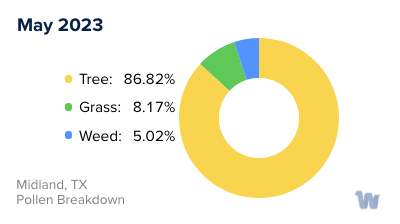


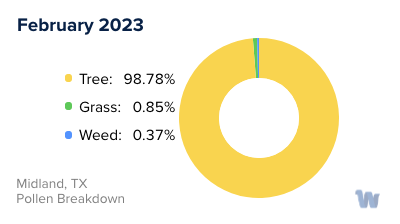
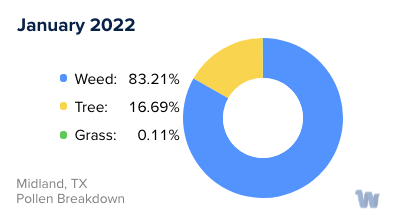
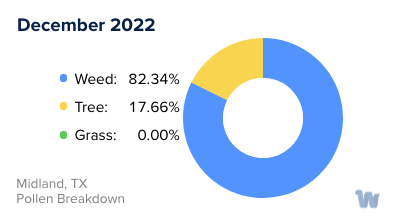
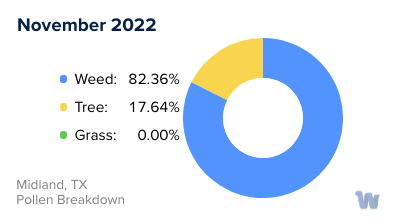
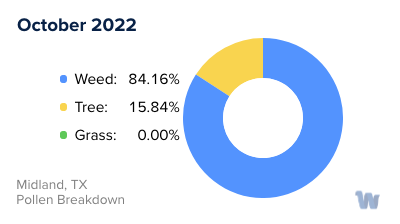

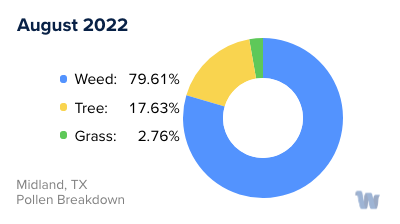
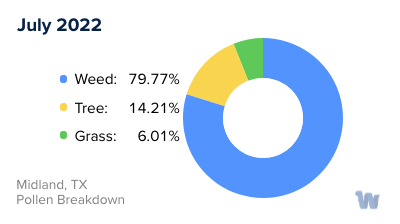


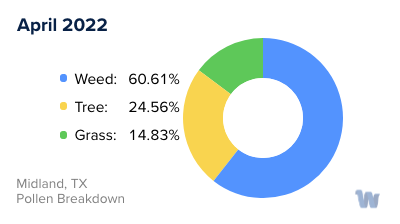
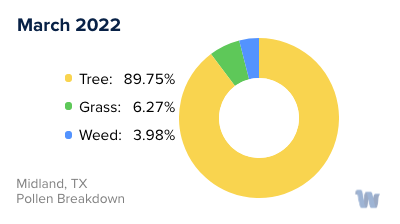
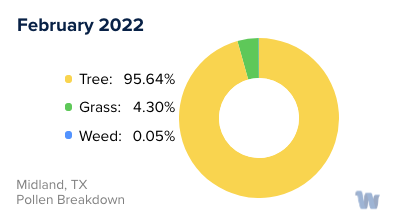
Pollen and Hay Fever in Midland, TX
In Midland, Texas, a variety of pollens can trigger allergy symptoms throughout the year. The three primary types of pollen that impact local residents are tree pollen, grass pollen, and ragweed pollen.
Tree pollen is typically produced by a number of different species. Mountain cedar, which is particularly abundant in central Texas, tends to release pollen from November to February. This small, light pollen can travel hundreds of miles and can be difficult to avoid. Other trees, such as elm, ash, and mulberry, add to the pollen count from January to May, overlapping slightly with the mountain cedar season.
Grass pollen usually emerges in the spring. From March to May, common grasses like Bermuda, Johnson, and Kentucky bluegrass release pollen that can irritate those who are sensitive to it. The symptoms can extend beyond the usual runny nose and watery eyes to include a sore throat and asthma-like symptoms.
The summer months of June and July typically offer a brief respite, with most common sources of allergies ceasing their pollen production and causing pollen counts to drop. However, this relief is temporary.
In August, ragweed pollen begins to make its appearance. Ragweed, a soft-stemmed, flowering weed, is populous in the tropical and subtropical regions of the Americas, and is particularly plentiful in the southwestern U.S.
including Texas. Ragweed season, which lasts until November, can cause symptoms such as runny noses, sneezing, itchy eyes, and even asthma flares in severe cases.
By the time ragweed season tapers off, it's time for the mountain cedar to come back into bloom, and the cycle starts all over again. It's important to note that pollen levels can vary from day to day and are influenced by factors such as weather patterns and temperature.
Understanding the types of pollen and their seasons in Midland, Texas, can help residents anticipate potential allergy triggers and better navigate the year-round allergy season.


